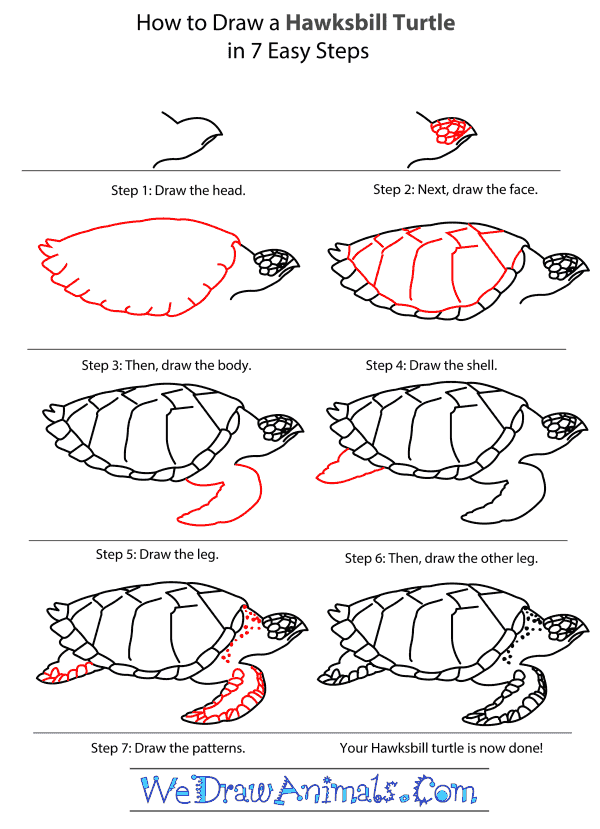In this quick tutorial you'll learn how to draw a Hawksbill Turtle in 7 easy steps - great for kids and novice artists.
The images above represent how your finished drawing is going to look and the steps involved.
Below are the individual steps - you can click on each one for a High Resolution printable PDF version.
At the bottom you can read some interesting facts about the Hawksbill Turtle.
Make sure you also check out any of the hundreds of drawing tutorials grouped by category.
How to Draw a Hawksbill Turtle - Step-by-Step Tutorial
Step 1: First, draw a line that curves down, sharply turns into a curve going to the side, and again sharply turns into a curve that goes down under itself. Draw another line that meets near the end of the first, and curves down.
Step 2: Draw a dot near the mouth. Draw a pattern of small, connected shapes that go around and over the eye.
Step 3: At the back of the head, draw a long curve going back for the top of the shell. Next, draw a chain of L-shapes and curves that go down from one end of the shell and back up to the other.
Step 4: Draw a long curve inside the shell that links the tops of the curves and L-shapes together. Draw large angles in the inner circle of the shell.
Step 5: From the bottom of the neck, draw a curve going down and back. From the front end of the bottom of the shell, draw a small curve going up slightly. Connect the two with a wavy line.
Step 6: Under the back end of the shell, draw a curve going down and back. Above this line, draw a wavy line that connects the end of the first one back to the shell.
Step 7: Draw dots on the neck and curves on the inner edge of the legs. Done! You can color it yellowish with dark brown or black patterns.
Interesting Facts about the HAWKSBILL TURTLE
The Hawksbill Turtle is a member of the reptile group and the scientific term for them is Eretmochelys imbricata. This species derived its name from a beak they have like the Hawk. They live in all tropical oceans of the world. While usually a brown mottled appearance, their color is dependent on the climate of water that they inhabit. The thick segments and serrated edge of their shell is unique. Similarly, they have claws on the ends of their flippers, and walk with alternating appendages as humans do.
Did you know?
- This animal was first documented in 1766.
- Their body is up to 3 feet long.
- They weigh up to 280 pounds.
- The Sponge makes up to 95 percent of their diet.
- They lay up to 140 eggs in their nest.
Their domain consists more often of shallow areas such as lagoons and reefs than the open deep ocean. Within such dwellings, there are caves or similar places for hiding from predators. Since they eat poisonous Jellyfish, their flesh is too toxic for eating. Algae and Sea Anemones are other popular food choices. These animals have a low population amount, and are considered to be critically endangered to the possibility of extinction.








